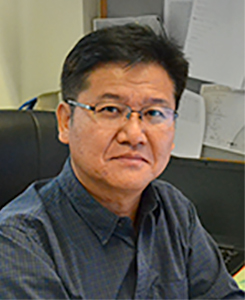
JANG IN-CHEOL
Adjunct Assistant Professor
Contact Information:
Principal Investigator
Temasek Life Sciences Laboratory
1 Research Link
National University of Singapore
Singapore 117604
6872 7409
jangi@tll.org.sg | dbsji@nus.edu.sg
Research Areas
Functional Genomics, Light Signaling, Plant Secondary Metabolism, Plant Biotechnology
Research Interests
Shade avoidance syndrome is a morphological and physiological response that plants display when they are subjected to the shade formed by surrounding neighbors. These responses include stem and petiole elongation, early flowering, and reduced leaf development, which results in loss of crop or vegetable yield. My lab’s research focuses on the roles of phytohormones in multiple shade avoidance responses. The diversity of plant secondary metabolites has stimulated broad systems biology approaches to identify the pathways/genes involved in their biosynthesis. My lab integrates metabolome and transcriptome analysis of aromatic plants/flowers to unravel biosynthetic pathways for plant secondary metabolites such as terpenoids and phenylpropanoids/benzenoids.
Selected Publications
-
Dhandapani S, Jin J, Sridhar V, Chua N-H, Jang I-C* (2019) Cytochrome P450 CYP79D73 participates in the biosynthesis of dominant floral scent compound 2-phenylethanol in Plumeria rubra. Plant Physiology 180: 171-184.
-
Zheng J, Zhuang Y, Mao H-Z, Jang I-C* (2019) Overexpression of SrDXS1 and SrKAH enhances steviol glycosides content in transgenic Stevia plants. BMC Plant Biology 19:1.
-
Kim MJ1, Zheng J1, Liao MH, Jang I-C* (2018) Overexpression of SrUGT76G1 in Stevia alters major steviol glycosides composition towards improved quality. Plant Biotechnology Journal doi: 10.1111/pbi.13035 (1equal contribution)
-
Dhandapani S, Jin J, Sridhar V, Sarojam R, Chua N-H, Jang I-C* (2017) Integrated metabolome and transcriptome analysis of Magnolia champaca identifies biosynthetic pathways for floral volatile organic compounds. BMC Genomics 18: 463.
-
Yin J-L, Wong W-S, Jang I-C*, Chua N-H* (2017) Co-expression of peppermint geranyl diphosphate synthase small subunit enhances monoterpene production in transgenic tobacco plants. New Phytologist 213:1133-1144.
-
Chung PJ1, Park BS1, Wang H, Liu J, Jang I-C*, Chua N-H* (2016) Light-inducible miR163 targets PXMT1 transcripts to promote seed germination and primary root elongation in Arabidopsis. Plant Physiology 170: 1772-1782. (1equal contribution)
-
Deng S, Jang I-C, Su L, Xu, J, Chua N-H (2016) JMJ24 targets CHROMOMETHYLASE3 for proteasomal degradation in Arabidopsis. Genes & Development 30: 251-256.
-
Kim MJ1, Jin J1, Zheng J1, Wong L, Chua N-H, Jang I-C* (2015) Comparative transcriptomics unravel biochemical specialization of leaf tissues of Stevia (Stevia rebaudiana) for diterpenoid production. Plant Physiology 169: 2462-2480. (1equal contribution)
-
Jin J1, Kim MJ1, Dhandapani S, Tjhang JG, Yin JL, Wong L, Sarojam R, Chua N-H, Jang, I-C* (2015) Floral transcriptome of Ylang Ylang (Cananga odorata var. fruticosa) uncovers biosynthetic pathways for volatile organic compounds and a multifunctional and novel sesquiterpene synthase. Journal of Experimental Botany 66: 3959-3975. (1equal contribution)
-
Wang H, Chung PJ, Liu J, Jang I-C, Kean MJ, Xu J, Chua N-H (2014) Genome-Wide Identification of Long Noncoding Natural Antisense Transcripts and Their Responses to Light in Arabidopsis. Genome Research 24: 444-453.
-
Jang I-C, Henriques R, Chua N-H (2013) Three Transcription Factors, HFR1, LAF1, and HY5 Regulate Largely Independent Signaling Pathways Downstream of Phytochrome A. Plant and Cell Physiology 53: 907-916.
-
Jang I-C, Niu Q-W, Deng S, Zhao P, Chua N-H (2012) Enhancing protein stability with retained biological function in transgenic plants. Plant Journal 72: 345-354.
-
Jang I-C, Chung PJ, Hemmes H, Jung C, Chua N-H (2011) Rapid and Reversible Light-mediated Chromatin Modifications of Arabidopsis Phytochrome A locus. Plant Cell 23: 459-470.
-
Jang I-C, Henriques R, Seo HS, Nagatani A, Chua N-H (2010) Arabidopsis PHYTOCHROME INTERACTING FACTOR Proteins Promote Phytochrome B Polyubiquitination by COP1 E3 Ligase in the Nucleus. Plant Cell 22:2370-2383.
-
Henriques R1, Jang I-C1, Chua N-H (2009) Regulated proteolysis in light-related signaling pathways. Current Opinion in Plant Biology 12: 49-56. Review, (1equal contribution)
-
Jang I-C, Yang SW, Yang J-Y, Chua N-H (2007) Independent and interdependent functions of LAF1 and HFR1 in phytochrome A signaling. Genes & Development 21: 2100-2111.
-
Jang I-C1, Yang J-Y1, Seo HS, Chua N-H (2005) HFR1 is targeted by COP1 E3 ligase for post-translational proteolysis during phytochrome A signaling. Genes & Development 19: 593-602. (1equal contribution)
-
Jang I-C, Pahk Y-M, Song SI, Kwon HJ, Nahm BH, Kim J-K (2003) Structure and expression of the rice class-I type histone deacetylase genes OsHDAC1, 2 and 3: OsHDAC1 overexpression in transgenic plants leads to increased growth rate and altered architecture. Plant Journal 33: 531-541.
-
Jang I-C1, Oh S-J1, Seo J-S1, Choi W-B, Song SI, Kim JH, Kim YS, Seo HS, Choi YD, Nahm BH, Kim J-K (2003) Expression of a bifunctional fusion of the Escherichia coli genes for trehalose-6-phosphate synthase and trehalose-6-phosphate phosphatase in transgenic rice plants increases trehalose accumulation and abiotic stress-tolerance without stunting growth. Plant Physiology 131: 516-524. (1equal contribution)
-
Jang I-C, Choi W-B, Lee K-H, Song SI, Nahm BH, Kim J-K (2002) High-level and ubiquitious expression of the rice cytochrome c gene OsCc1and its promoter activity in transgenic plants provides a useful promoter for transgenesis of monocots. Plant Physiology 129: 1473-1481.
